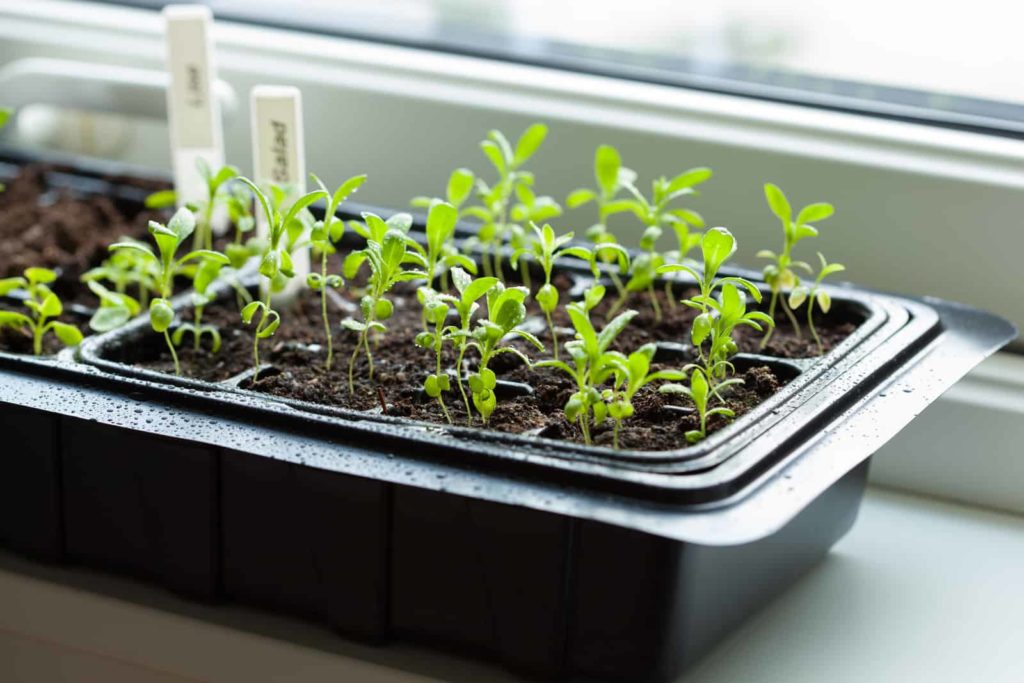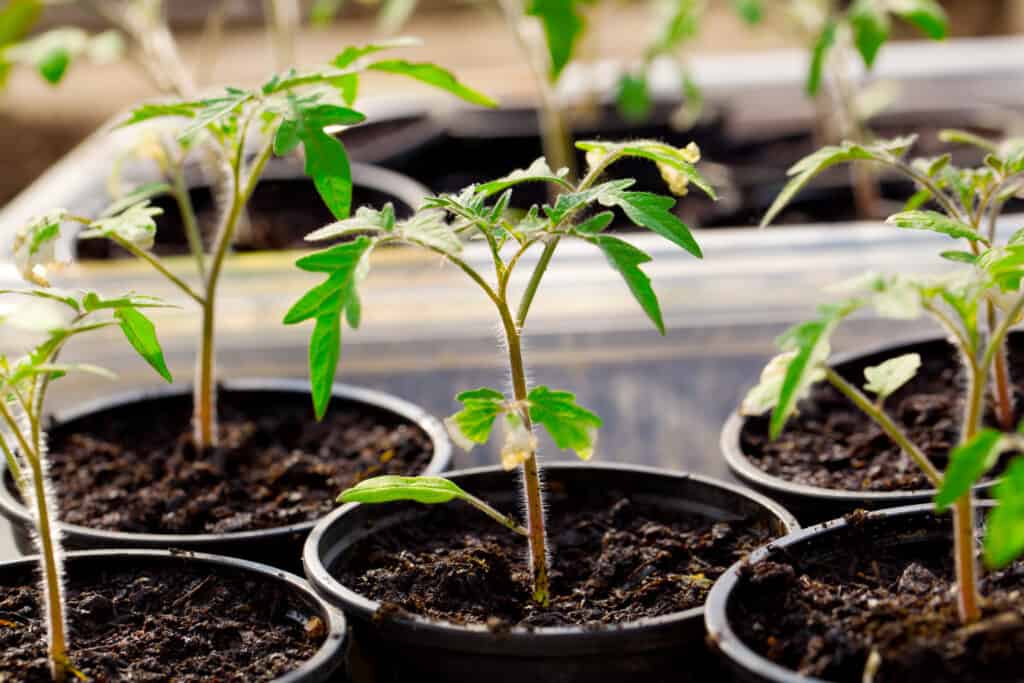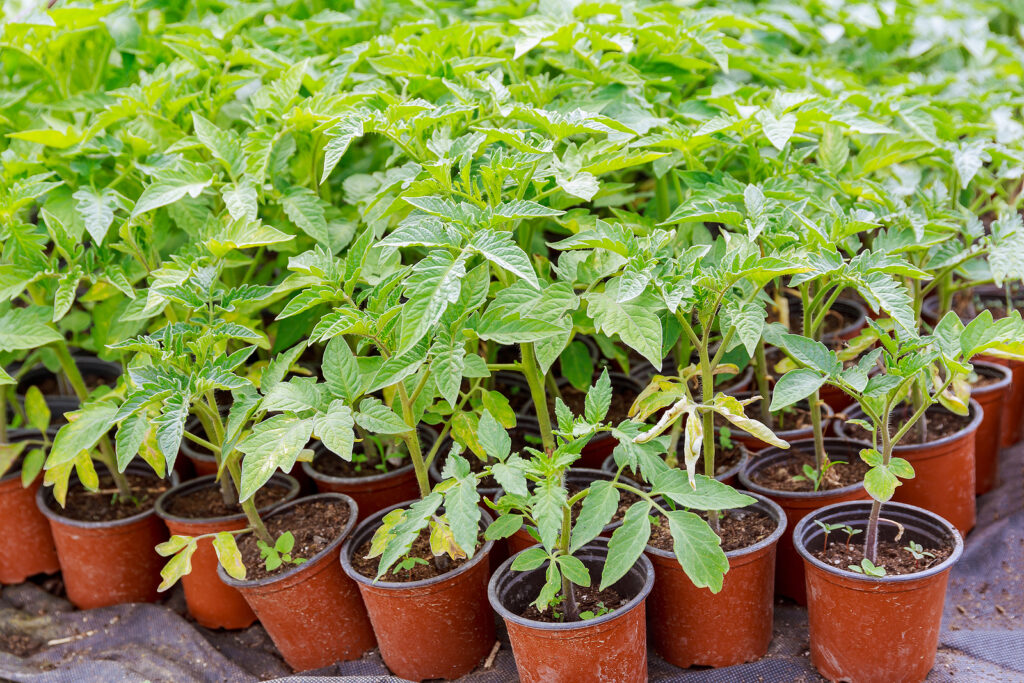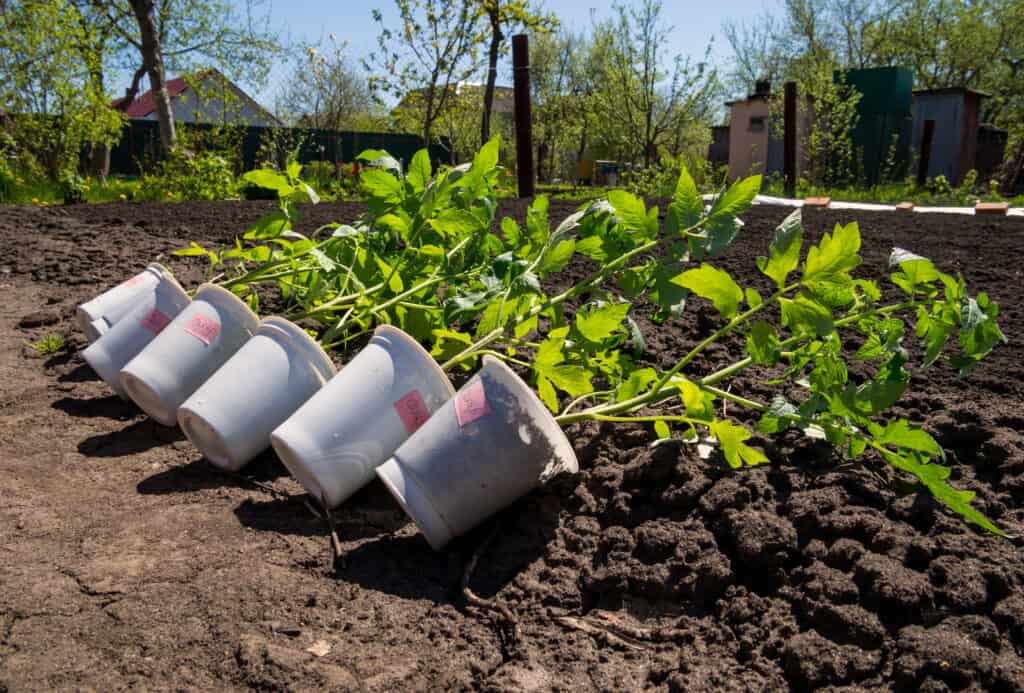Tomatoes are a tender, warm-weather crop. Start tomatoes indoors 10 to 8 weeks before the last expected frost in spring. Set tomato seedlings into the garden after all danger of frost is past.
Plant tomato seedlings in the garden 4 weeks after the last frost. The garden soil temperature for setting out transplants should be at least 60°F (16°C).
Tomatoes can be set in the garden sooner if they are protected from the cold by a plastic tunnel or other season-extending devices.
For an extended or staggered harvest, plant early, mid, and late, or long-to-maturity varieties in mid to late spring.

Types of tomatoes
There are more than 1,000 varieties of tomatoes—most are red, and others are pink-orange, yellow, purple, brown, whitish-green, or striped.
Determinate tomatoes come to harvest earlier than indeterminate varieties. Determinate varieties are a good choice for planting in spring for an early summer harvest and in fall for a quick harvest before the first frost.
Tomatoes grow best in a bit of sandy, well-drained loam rich in organic matter. Add plenty of aged compost to the planting bed before planting. Plant tomatoes in full sun. Eve moisture throughout the growing season is essential for flavorful fruit development. Be sure to keep the space around tomatoes well-weeded, especially in the 5 weeks after transplanting.
Good Products for Growing Tomatoes at Amazon:
- Espoma Garden Tone 3-4-4 Fertilizer
- Epsom Salt Plus Plant Nutrients Magriculture
- Tomato Grower’s Answer Book
- Neem Bliss 100-% Cold Pressed Neem Oil
- Safer Brand Insect Killing Soap
- PyGanic Botanical Insecticide
- Monterey BT Caterpillar Killer
- Harris Diatomaceous Earth with Duster
- Natures Good Guys Beneficial Nematodes
- Southern Ag Liquid Copper Fungicide

Best tips on How to Grow Tomatoes.
For more tips, get Tomato Grower’s Answer Book
Small tomatoes are commonly called cherry tomatoes; large tomatoes are called beef or beefsteak tomatoes; egg-shaped tomatoes are called paste or jam tomatoes. Choose tomatoes to grow according to how you plan to use them: cherry tomatoes for salads and garnish, beefsteak tomatoes for slicing, and paste tomatoes for sauces.
Some tomatoes grow to bush size—these are called determinates. Others sprawl or grow as vines—these are called indeterminates. Tomatoes that are neither busing nor vining are called semi-determinates.
Tomatoes mature in 50 to 90 days from the time they are transplanted. Tomatoes are commonly transplanted about 40 to 60 days after seed sowing. That means even the quickest maturing tomato variety requires about 90 days to reach maturity from sowing.
Good Products for Seed Starting Success at Amazon:
- Jump Start Germination Station w/Heat Mat Tray, 72-Cell Pack, Dome
- Espoma Seed Starting Mix
- 200 Count- Jiffy 7 Peat Soil Seed Starting Plugs
- Seed Starter Kit with Humidity Dome (120 Cells Total Tray)
- AgrobriteT5 Fluorescent, 2-Foot, Grow Light System
Tomato planting details
- Sowing depth: ¼- ½ inch (6-12mm)
- Space between plant after thinning: 2-4 feet (.6-1.2m)
- Days to sprout: 10
- Days to harvest: 60-90
- Storage period: 1-2 weeks
- Seeds per 100-row feet: 1 packet (50 plants)
- Yield per 100-row feet: 300 pounds (136 kilograms)
- Early season varieties: Early Girl, Green Grape, Juliet, Stupice, Sun Gold, Sweet 100.
- Midseason varieties: Arkansas Traveler, Better Boy, Celebrity, Cherokee Purple, Marglobe, Red Brandywine, Roma
- Late season varieties: Ace 55, Big Boy, Mortgage Lifter, Pink Brandywine, San Marzano

Tomato seed starting temperature
- The optimal seed starting temperature for tomatoes is between 70°F to 80°F
- The seed will germinate best where the bottom temperature is about 85°F.
- Seedlings grow best when daytime temperatures are between 70°F and 75°F during the day and between 60°F and 65°F during the night.
Tomato seed starting soil
- Use a sterilized planter mix. A sterilized, pasteurized soil or commercial seed starting mix will be free of weeds and fungi that cause seedlings to collapse and die.
- You can pasteurize your own garden soil: bake the soil in a shallow pan at 200°F for an hour or two (the smell will be bad). If you place a potato in the oven with the soil, the soil will be sterilized when the potato has baked.
- To make your own seed starting mix, combine equal parts sand, vermiculite or perlite, and aged compost.
Sowing tomato seeds
- Tomato seeds can be started in pots, peat pellets, or flats. Be sure there are holes in the bottom for drainage.
- If you sow seed in 3- to 4-inch clay or peat pots, fill the pots to ½ inch from the top.
- Thoroughly moisten the seed starting mix before sowing to make sure it is not dry below the surface.
- Sow seed ¼ to 1/3 inch deep; space seeds 1 inch apart. As a general rule, sow seed three times the depth as the width of the seed.
- Firm the seeds into the soil with a piece of wood or a flat object; then add a thin layer of about ¼ inch of moist soil mix over the seeds and level it and firm again. This will bring seeds into good contact with the soil which is important for germination.
- Sow twice as many seeds as you need plants so that you can later choose from the strongest seedlings.
- Do not sow seeds too deeply otherwise the seeds may rot before they germinate.
Tomato sowing and planting tips
- Grow tomatoes from seeds or seedlings.
- Seed is viable for 4 years.
- Tomatoes are commonly started indoors in a greenhouse or in a warm, well-lit sunroom or kitchen.
- Sow tomatoes 10 to 7 weeks before you intend to set plants out into the garden.
- Sow tomatoes in individual pots with a light potting mix.
- Sow 3 to 4 seeds in a pot then clip away the weaker seedlings once the strongest seedling is about 2 inches (5 cm) tall.
- Sow seed ½ inch (13 mm) deep.
- Germination soil temperature can range between 65-86°F (18-30°C); the optimum soil temperature for germinating seed is 86°F (30°C).
- Germination takes 5 to 7 days at 75°F (24°C) or warmer.
- Keep seed starting mix just moist until seeds germinate.
- Tomato seed can be sown directly in the garden if the soil temperature is warm enough—and there are enough days in the season for plants to reach maturity.
- Seeds are commonly started indoors so that seedlings can go into the garden when the outdoor soil temperature is at least 55°F (13°C) and the nighttime air temperatures is consistently 50°F (10°C) or warmer; plants will not thrive and should be protected if the air temperature is any cooler.
- Do not transplant seedlings into the garden until all danger of frost has passed unless the plants will be protected under a plastic tunnel or cloche.
- Seedlings started indoors should be kept under grow light or in a sunny window after germination to ensure bushy growth.
- Water to keep the seed starting mix from drying.
- Fertilize with fish emulsion or a soluble complete fertilizer at half strength.
- Transfer seedlings to a larger container once they are 2 to 4 inches (5-10 cm) tall; be sure that seedlings have sufficient room for root growth. This process is called “potting up”; continue to pot up seedlings as they outgrow containers—until they are transplanted into the garden or a very large container.
- Transplant tomatoes into medium-rich garden soil 12-24 inches (30-60 cm) apart for determinate varieties; 24-46 (30-90 cm) apart for indeterminate varieties.
- Add aged compost to planting beds in advance of transplanting.
- Tomatoes prefer a soil pH range of 5.5 to 6.8.
- Grow tomatoes in full sun for the best yield.
- If you plant seedlings started by another grower, select plants 6 to 8 weeks old; usually in a 4-inch (10 cm) pot. Check the bottom of the pot to be sure roots are not growing through and the plant is not root-bound.
- When transplanting tomato seedlings, bury all but 2 inches (5 cm) of the plant; first clip away leaves and branches below the top set or two of leaves—new roots will grow from the buried stem.
- Avoid planting tomatoes where potatoes, peppers, or eggplants have grown recently.
- Fertilize with an organic fertilizer such as fish emulsion at half strength.
- Common tomato pest enemies include aphids, leafhoppers, cabbage loopers, Colorado potato beetles, cucumber beetles, flea beetles, tomato hornworms, whiteflies, and others.
- Common diseases include damping off, early blight, late blight, fusarium wilt, bacterial spot and wilt, sunscald, tobacco mosaic, verticillium wilt, and mosaic virus.
Good Products for Growing Tomatoes:
- Espoma Garden Tone 3-4-4 Fertilizer
- Epsom Salt Plus Plant Nutrients Magriculture
- Tomato Grower’s Answer Book
- Neem Bliss 100-% Cold Pressed Neem Oil
- Safer Brand Insect Killing Soap
- PyGanic Botanical Insecticide
- Monterey BT Caterpillar Killer
- Harris Diatomaceous Earth with Duster
- Natures Good Guys Beneficial Nematodes
- Southern Ag Liquid Copper Fungicide
Care before tomato seedlings emerge
- Keep the seed starting mix or soil moist but not wet after sowing; gently water with a fine spray being careful not to wash away the seed.
- Seeds can be started in a bright window or under lights set about 2 inches above the plants.
- Maintain soil temperature between 75°F and 85°F; seeds will germinate in 7 to 10 days. To maintain an even soil temperature, use a propagating mat or rubberized “electric blanket” placed under starting pots, flats, or trays.
- Place the seed-starting container inside a clear plastic bag or tent or cover the container tightly with a plastic sheet to retain moisture and warmth until the seeds germinate. You can also lay a piece of newspaper on the containers until seedlings emerge. To germinate seeds require warmth and moisture, not light.
- Remove the plastic bag or sheet when the seeds emerge.

Tomato seedling care
- When seedlings emerge, give them full sunshine or place them under grow lights. Use two 48-inch, 40-watt fluorescent tubes placed a few inches above the seedlings. These can be supplemented with a couple of incandescent bulbs to provide the “red light” that growing plants need.
- Keep lights on 16 hours a day when using fluorescent lights.
- Plants must have lights off at least 8 hours a day to grow strong.
- Set tomato seedlings one or two inches below the fluorescent tubes and maintain that distance as the plants grow. If plants are too far away they will stretch and develop thin, weak stems.
- Check seedlings every day as they grow. Be sure to keep grow lights at a constant distance above the seedlings.
- Seedlings growing in a window should be turned every day so that they do not develop a permanent lean–heliotropism means growing towards the sun.
- Keep seedlings near a constant 70°F; temperatures greater than 70°F may produce tall, spindly sprouts. Windowsills may get hot during the day and cold at night; seedlings grow best if kept at an even temperature.
- Keep the soil moist, but not wet. Water or mist plants gently to avoid washing them out. Use room temperature water.
Feeding tomato seedlings
- Do not fertilize seedlings right away; wait a week or two or until the first repotting, then mix in a small amount of balanced, water-soluble fertilizer in the plants’ water.
Starting tomatoes in a cold frame
- Tomato seeds can be started in a cold frame–a glass- or plastic-covered box, heated by solar radiation as long as the temperatures remain warm enough for germination and growth.
- Seedlings growing in a cold frame or greenhouse should receive 12 hours of sunlight each day.
Interplanting tomatoes
Plant tomatoes with bush beans, chives, cucumbers, lettuce, marigolds, and peppers.
Container growing tomatoes
Choose a container large enough for the type of tomato you are growing; indeterminate tomatoes require at least a 15-gallon container, and larger would be better. Determinate tomatoes that can grow in slightly smaller containers.
Good Products for Raised Bed Growing at Amazon:
- Galvanized Raised Bed 8×3
- Cedar Raised Bed 4×8
- Elevated Cedar Planter 4×2
- Walk-In Greenhouse Tunnel 15x7x7
- Row Cover for Freeze Protection 10×30
Tomato planting calendar
- 6-8 weeks before the last frost in spring: start seed indoors for transplanting to the garden in 6 to 8 weeks.
- 1-2 weeks before the last frost in spring: transplant seedlings to the garden under a plastic tunnel or begin to harden off seedlings; minimum soil temperature is 50°
- After the last frost in spring, set transplants into the garden; protect plants from chilly nights or cold weather with a cloche or by wrapping spun poly row covers around the tomato cage.

Tomato seedling planting dates
(These dates are for the Northern Hemisphere)
| Average date of the last frost | Planting dates |
| Jan. 30 | Feb. 1-Apr. 1 |
| Feb. 8 | Feb. 20-Apr. 10 |
| Feb. 18 | Mar. 1-Apr. 20 |
| Feb. 28 | Mar. 10-May 1 |
| Mar. 10 | Mar. 20-May 10 |
| Mar. 20 | Apr. 1-May 20 |
| Mar. 30 | Apr. 10-June 1 |
| Apr. 10 | Apr. 20-June 1 |
| Apr. 20 | May 5-June 10 |
| Apr. 30 | May 10-June 15 |
| May 10 | May 15-June 15 |
| May 20 | May 25-June 15 |
| May 30 | June 5-20 |
| June 10 | June 15-30 |

Types and classifications of tomatoes
There are several tomato types and classifications to choose from and grow. Here are some basics:
Tomato growth form or habit
- Determinate bush types that grow to a predetermined size and then stop—about 3 feet tall; fruits ripen all at once.
- Indeterminate vine-like plants can grow easily to 6 feet tall or taller; fruits ripen over an extended period—usually until the plant is killed by frost.
- Semi-determinate types grow taller than determinates but smaller than indeterminates; fruits ripen over an extended period.
Common types and names of tomatoes
There are more than 1,000 varieties of tomatoes; here is a short guide of types commonly grown:
- Beefsteak types have large, slightly elliptical-shaped fruits; commonly used for slicing.
- Cherry types have small fruits about 1 inch (2.5 cm) in diameter, usually red or yellow-gold colored.
- Grape-types is elliptical, egg- or pear-shaped about the size of a grape.
- Paste types are small, oval, thick-meated fruits used for making paste or in cooking.
- Pear types are small cherry tomatoes that are egg- or pear-shaped.
- Plum types are also called Italian plums or Roma tomatoes; they are elongated usually 2-4 inches long.
- Heirlooms can vary in size and appearance; these are varieties that have been in cultivation since the late 1940s before the first hybrids were introduced. Seeds from heirlooms can be saved and will grow true.
- Hybrids are first-generation varieties from controlled parent lines; seeds from these tomatoes will not grow true.
- Open-pollinated tomatoes are tomatoes whose seeds can be saved and will grow true to the parent—unlike hybrids.
Botanical Name: Lycopersicom esculentum
Tomatoes are a member of the Solanaceae family, other members of this family are peppers, eggplants, and potatoes.
More tips: How to Grow Tomatoes
Tomato articles at Harvest to Table:
How to Plant and Grow Tomatoes
How to Choose a Tomato for Your Garden
Growing Tomatoes in Containers
Growing Early Season Tomatoes for Great Taste
Epsom Salt, Milk, and Organic Fertilizers for Tomatoes and Peppers
How to Prevent Blossom Drop – Tomatoes and Peppers
How to Harvest and Store Tomatoes
Nine Ways to Cook and Serve Tomatoes
Tomato Sauce–Basic, Herbed, or Vegetables Added
How to Make Tomato Juice Simply
How to Home Can Tomatoes for Beginners
How to Sun Dry and Oven Dry Tomatoes
Tomato Growing Problems Troubleshooting
How to Prevent Tomato Blossom Drop
How to Identify Early Blight, Late Blight, and Leaf Spot
Tomato Hornworm Organic Pest Control
Garden Planning Books at Amazon:
- Vegetable Garden Almanac & Planner
- Kitchen Garden Grower’s Guide Vegetable Encyclopedia
- Tomato Grower’s Answer Book
- Vegetable Garden Grower’s Guide















